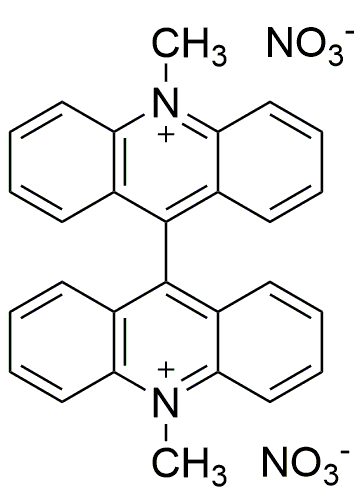10,10'-Dimethyl-9,9'-biacridinium dinitrate is widely utilized in research focused on:
- Fluorescent Probes: This compound serves as a powerful fluorescent probe in biochemical assays, allowing researchers to track cellular processes with high sensitivity.
- Photodynamic Therapy: In the medical field, it is explored for use in photodynamic therapy, where its ability to generate reactive oxygen species can help target cancer cells.
- Electrochemical Sensors: It is employed in the development of electrochemical sensors for detecting various biomolecules, enhancing the accuracy and efficiency of diagnostic tools.
- Material Science: The compound is used in creating advanced materials with unique optical properties, which can be applied in electronics and photonics.
- Research on Reactive Species: It aids in studying reactive nitrogen species in biological systems, providing insights into oxidative stress and related diseases.
General Information
Properties
Safety and Regulations
Applications
10,10'-Dimethyl-9,9'-biacridinium dinitrate is widely utilized in research focused on:
- Fluorescent Probes: This compound serves as a powerful fluorescent probe in biochemical assays, allowing researchers to track cellular processes with high sensitivity.
- Photodynamic Therapy: In the medical field, it is explored for use in photodynamic therapy, where its ability to generate reactive oxygen species can help target cancer cells.
- Electrochemical Sensors: It is employed in the development of electrochemical sensors for detecting various biomolecules, enhancing the accuracy and efficiency of diagnostic tools.
- Material Science: The compound is used in creating advanced materials with unique optical properties, which can be applied in electronics and photonics.
- Research on Reactive Species: It aids in studying reactive nitrogen species in biological systems, providing insights into oxidative stress and related diseases.
Documents
Safety Data Sheets (SDS)
The SDS provides comprehensive safety information on handling, storage, and disposal of the product.
Product Specification (PS)
The PS provides a comprehensive breakdown of the product’s properties, including chemical composition, physical state, purity, and storage requirements. It also details acceptable quality ranges and the product's intended applications.
Certificates of Analysis (COA)
Search for Certificates of Analysis (COA) by entering the products Lot Number. Lot and Batch Numbers can be found on a product’s label following the words ‘Lot’ or ‘Batch’.
*Catalog Number
*Lot Number
Certificates Of Origin (COO)
This COO confirms the country where the product was manufactured, and also details the materials and components used in it and whether it is derived from natural, synthetic, or other specific sources. This certificate may be required for customs, trade, and regulatory compliance.
*Catalog Number
*Lot Number
Safety Data Sheets (SDS)
The SDS provides comprehensive safety information on handling, storage, and disposal of the product.
DownloadProduct Specification (PS)
The PS provides a comprehensive breakdown of the product’s properties, including chemical composition, physical state, purity, and storage requirements. It also details acceptable quality ranges and the product's intended applications.
DownloadCertificates of Analysis (COA)
Search for Certificates of Analysis (COA) by entering the products Lot Number. Lot and Batch Numbers can be found on a product’s label following the words ‘Lot’ or ‘Batch’.
*Catalog Number
*Lot Number
Certificates Of Origin (COO)
This COO confirms the country where the product was manufactured, and also details the materials and components used in it and whether it is derived from natural, synthetic, or other specific sources. This certificate may be required for customs, trade, and regulatory compliance.


